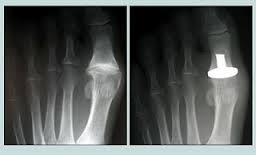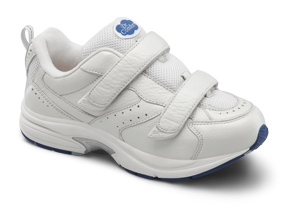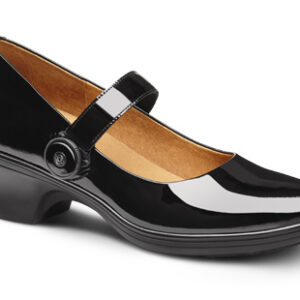Hallux Limitus Treatment
Conservative Hallux Limitus Treatment for mild cases may include prescription foot orthotics, shoe modifications (to take the pressure off the toe and/or facilitate walking), medications (anti-inflammatory drugs), injection therapy (corticosteroids to reduce inflammation and pain) and/or physical therapy can be effective. Any damage done to the joint will not be repaired by these treatments, but pain and inflammation can be reduced.

Hallux rigidus on the Left and the same joint post surgery with a Hemi Implant.
Surgical Hallux Limitus Treatment is the only way to eliminate or reduce pain in some cases. There are several types of surgery for the treatment of hallux rigidus and hallux limitus. The type of surgery is based on the the age of the patient, level of pain, activity level, and progression of the arthritis. Stage 1 hallux rigidus involves some loss of range of motion of the big toe joint or first MTPJ and is often treated conservatively with arch supports, prescription foot orthotics, NSAIDS, or steroid injections.
Stage 2 hallux rigidus involves greater loss of range of motion and cartilage and may be treated with cheilectomy in which the metatarsal head is reshaped, bone spurs removed, and subchondral drilling to increase scar tissue/cartilage in the joint.
Stage 3 hallux limitus often involves significant cartilage and range of motion loss and may be treated by various implants, or fusion of the joint. Stage 4 hallux limitus, also known as hallux rigidus involves complete loss in range of motion of the big toe joint and cartilage loss.
Stage 4 hallux rigidus may be treated via fusion of the joint (arthrodesis) or with implant arthroplasty. in which on or both sides of the joint are resurfaced or a hinged implant is used. Fusion of the joint is often viewed as more definitive but may lead to significant alteration of gait. The implants termed “two part unconstrained” implants in which a “ball” type device is placed on the first metatarsal head and “socket” portion on the base of the big toe do not have a good long term track record. The hinged implants have been in existence since the 1970s, they have been continually improved and have a great record of improving long term function.





